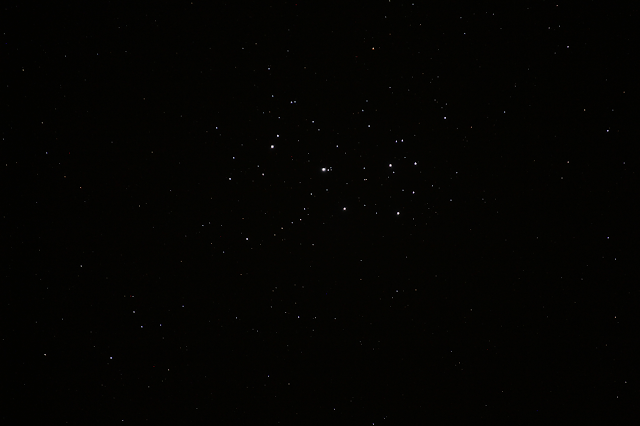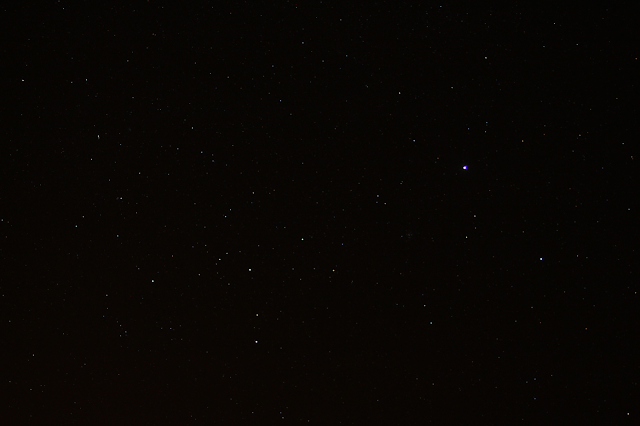A camera can be a small telescope. It collects lights, it has a larger aperture than your eye. A lens is a
lens.
As I wrote in a previous article: How to photograph stars and constellations, you can use any camera to photograph the sky. You should be realistic and understand that you are photographing mostly wide-filed photos. Entire constellations or large objects with a telephoto lens. The photos will help you see more stars, observe their different colors, and even to find deep sky objects such as clusters, nebulas and even galaxies.
A DSLR is recommended and the better your lens the better the results but even with a compact camera it is possible to get nice results.
A DSLR is recommended and the better your lens the better the results but even with a compact camera it is possible to get nice results.
Photos can be taken from anywhere but to avoid light pollution it is best to go to darkest as possible places. No need to mention that a sturdy tripod is a must.
The major problem of photographing stars is that the earth rotate and the stars are smudged from dot to lines. You can use this rotation to produce great star trails photos but our aim in this specific article is to better see the stars and faint objects.
The rule of thumb is that the longest exposure should not be more than 500/focal-length. For example, if you use a 28mm lens you can expose for 18 seconds without noticing much smudging. These number is correct for Full-Frame cameras. If you are using an APS camera, you should adjust by the crop factor (mostly 1.5) so 18 seconds becomes just 12. If you are using a telephoto lens you will have shorter exposures time.
The rule of thumb is that the longest exposure should not be more than 500/focal-length. For example, if you use a 28mm lens you can expose for 18 seconds without noticing much smudging. These number is correct for Full-Frame cameras. If you are using an APS camera, you should adjust by the crop factor (mostly 1.5) so 18 seconds becomes just 12. If you are using a telephoto lens you will have shorter exposures time.
So what to do? Use higher ISO, 400 800 or even 1600 depends on your specific model and open the aperture as possible.
Focusing is another important matter. Manual focusing is a must. Try to find a bright star and use LiveView to better focus. If you are not sure, check your photo after a single exposure, zoom into it and adjust the focus as needed.
A release cable/remote is also necessary to prevent the shake caused by pressing the shutter. If you do not have a remote/release cable use the self-photo feature to add 2 seconds delay before each photograph.
To save time I take the first photo with a very high ISO (3200 or 1600), short exposure and without noise reduction. After I set the composition as I like I use a lower ISO and the longest possible exposure. Usually, I use the built-in "log exposure noise reduction" but it can be done later in a software if you take one or two photos of the same exposure time with the lens cap on.
A release cable/remote is also necessary to prevent the shake caused by pressing the shutter. If you do not have a remote/release cable use the self-photo feature to add 2 seconds delay before each photograph.
To save time I take the first photo with a very high ISO (3200 or 1600), short exposure and without noise reduction. After I set the composition as I like I use a lower ISO and the longest possible exposure. Usually, I use the built-in "log exposure noise reduction" but it can be done later in a software if you take one or two photos of the same exposure time with the lens cap on.
To take your photos to the next level you will need a tracker device. The tracker is pointed to the polar star (or to the relevant area in the southern hemisphere) and rotates in the opposite direction to the earth, thus eliminating the smudging and enables longer exposures. I am using the Ioptron tracker, if you are handy you can build your own device (look for instructions to build a "barn door tracker").
If you go for a tracker notice that there are models with additional small finderscope which will give you much better results and you should buy that model. also notice that some models have a 3/8" mount while most tripods have a 1/4" mount, so a small adapter might be required (It is very cheap adapter).
Using the tracker is simple you put it on a tripod, points it to the north star, use the finderscope for exact alignment (I use a small app for my smartphone to do this - Polar scope finder, there are also free apps for this purpose). Put the ball-head on the tracker (carefully, not to move the tracker) and point the camera to the area you want to photograph. From time to time check that the tracker still points to the correct place.
Here are some examples, all photos are 30second exposure. the Pleiades cluster - M45 - is a nice object for 300mm lens.
 |
| M45-Pleiades |
Here is the same photo without tracking, the difference is clear.
 |
| M45-Pleiades |
The double cluster in Perseus.
 |
| הוסף כיתוב |
The beehive cluster (M44) at Cancer.
 |
| The beehive cluster (M44) at Cancer. |
The great dog with Sirius, the brightest star.
 |
| The great dog - Canis Major |
Here is the same photo of Canis Major without tracking. Since the focal length is wider there isn't much smudging but there is still a considerable amount.
 | |
|
Orion constellation. With blue Rigel (bottom right) and orange Betelgeuse (Top left), Orion belt in the middle and even a hint of Orion Nebula (m42)
 |
| Orion constellation |